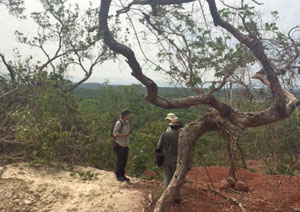As an economic geologist it has never ceased to amaze me how the non technical investor embraces the precarious process of mineral exploration and the intricate business of mining. In many cases it appears to me more like a reliance on luck riding a “flutter” and of often not inconsequential proportions I might add.
In 1905 T.A. Rickard[1] wrote in his book The Economics of Mining that 95 per cent of commercial and industrial enterprises which are started every year ultimately prove unprofitable. Such failure rates seem still to be the case[2]. Rickard stated that the primary cause of failure was incorrect estimation of the trade conditions which are innumerable, intricate and constantly changing but that nearly all of them are the result of merciless competition. So it seems competition and not adapting is key. Another recent study mentioned incompetence as a major factor in business failure[3]. Rickard argued that there is less competition in the business of mining which may be true but I would stress that one should always be aware of where your mine sits on the cost curve.
So the odds against success seem to be stacked against us not only in the mining sector but also in general business.
A tall but small fund manager at the last Mines and Money conference I attended in London before Christmas was quite indignant and irritated as he confronted me over a coffee with the recent dismal discovery record of the mining sector even when exploration funding was flowing again in 2010 and 2011. I am surprised he was surprised. Is it all down to the explorer? At what point does honest exploration failure give way to ineptitude? How much of the lack of success lies with the gatekeepers of mining finance which do not do their homework?
I wrote in my blog about a year ago now about how risky is the business of gold exploration. Based on data compiled by Newmont Gold Corporation from a nice round 10,000 gold prospects which were being explored episodically, to a greater or lesser degree, there is a one in 1,000 chance every year of finding an economic gold deposit greater than 100,000 ounces and only one of those will be greater than four million ounces. Some years there are more elephants and some years there are none. Failures naturally do not attract media coverage but rampant optimism based on sizzling grades from the first couple of drill-holes usually becomes viral.
Nevertheless Rickard felt that the investor in mining enterprises whether assessing a potential mine or evaluating an operating mine should have a better run for his money than statistics seem to indicate. Don’t take a “flyer” and trust altogether in luck and invest your money in an exploration or mining project on the strength of a printed prospectus or the advice of an interested friend without the preliminary investigation and site visit of a reliable experienced geologist with a basic grasp of commercial reality. Remember that prospectus and the embedded geologist’s report has been paid for by the Promoter – as an investor you surely need a truly independent opinion.
The great John Hays Hammond at the turn of the last century asked Chester Beatty to carry out an examination of Stratton’s Independence Mine in the Cripple Creek mining district of Colorado. Beatty and his friend Harry Titcomb, who also graduated from America’s first mining school at Colombia university, crawled over every foot of the Stratton’s mine, probing, questioning and taking hundred’s of samples to assay. Titcomb built a glass model of the mine to better understand the structural complexity controlling the localisation of the gold by tracing the anastomosing veins into the deepest levels of the mineralising system. They worked with hardly a break for five weeks – underground all day and arguing out their problems by night.
When you draw something by hand as my old professor of paleontology, Professor Irving Tesmer used to say “you have no choice but to carefully observe”. That is why having to draw an outcrop or interpret a cross section is an intimate connection involving the coordination of the eye, the hand and the brain which is such a much superior way to really understand geology compared to the instant images generated by the computers of the modern age.
Leonardo da Vinci said that “simplicity is the ultimate sophistication”. What Beatty and his mate Titcomb were doing was simply old fashioned and thorough due diligence and the most sophisticated way to evaluate a mining project. The gatekeepers of mining finance would do well to take note. The statistics of failure should not just be based only on the borrower but also on the lender.
My distillation of the mining business is simply to discover, uncover and recover. Once you start to mine an ore body is a depleting asset and so it should be obvious that exploration to discover is vital to prolonging the business. The mining method and scale determines the cost of uncovering and mining processing of the mineralisation will determine if you can profitably recover the metal which is the definition of ore.
I note that the Chairman of the troubled Blackrock World Mining Investment Trust has offered his most sincere regret for shedding of 26.4 per cent of its net asset value in 2014. The statement which is not simple continues to say that “the company continues to employ, and refine on an ongoing basis, robust due diligence and supervisory processes designed to minimise the risk of such issues arising in the future.” Blackrock had apparently expected an improving world economy to support commodity demand and underpin commodity prices but supply growth managed to overwhelm demand and resulted in many commodity prices falling sharply. I would have thought that mine supply would be easier to quantify than demand but it is sobering that even if you have the resources of a Blackrock and access to the expensive research of Wood MacKenzie and CRU you can still end up bewildered. Another reason for a significant dent in the fund’s valuation was the iron ore price and Ebola as in October it took a steep write down after the failure of one of its largest investments in London Mining – with a mining project in Sierra Leone.
There are a few factors I like to keep in mind when considering a considerable investment in a potential or producing mine.
Let’s assume that there is security of tenure (title is firm) and that the local community is supportive of the project because of management’s painstaking approach to building trust through timely communication without disingenuous obfuscation and callous promises. The following may be so obvious to the tenderfoot but it is amazing how even the most sanguine and experienced get distracted and even sometimes delusional.
Grade is king and not a bad proxy for profitability.
Metallurgy – is there an efficient and cost-effective process to liberate the metal, those investing in rare-earth projects and gold-rich volcanogenic deposits should be aware.
Rock value – a combination of grade and recoverability once costs and charges have been deducted – basically the net smelter return (NSR) per tonne of rock.
People – probably one of the biggest reasons for failure – do your homework. Also it might be little compensation but good people will find a good project even if the current one fails.
Continuity – every deposit is different and appreciate that it is interpretation, bias and creativity which fleshes out the skeleton based on exploratory probing by drill and adit.
Cut-off and capping – in the wrong hands it is a brutal way to emasculate a mineral deposit.
Composite & size-selection – a subjective way to hugely impact grade and tonnage and imply continuity where in reality none exists.
Mining equipment – fit for purpose?
Joined-up-thinking – economies of scale without denting profit margins and optimisation of development scenarios. It takes time to permit a brownfield project may take longer than the current life of mine so identify the critical path and begin technical due diligence early.
Resource – should be big enough to supply a mill so at least you get the capital investment back.
Sovereign risk – Who would have thought that the Australian government would have turned so capriciously on its mining industry. The issues are usually obvious but often over done – Guinea produces 30 per cent of the world’s bauxite – coup d’états never impacted Ghana’s gold production.
Mesmerising financial models – a favourite tool of the city analyst who never goes in the bush – perfect math but garbage-in-garbage-out.
It is a nearly a year since I started this blogging thing and as T.A. Rickard wrote 110 years ago I hope that by writing this and inviting the consideration of this subject I can induce some of my fellow workers to grasp their pens and expose their ideas[4]. I believe the long-suffering investing public might profit from the discussion.
I am off to the Holy Land with my family for the next two weeks to celebrate three-score years on this earth and where we hope to have a holiday of biblical proportions. I do have some capacity in my maturing years and once back from my pilgrimage I hope to continue providing some modicum of guidance and advice to those who wish to listen on how to maximise the value and minimise the risk of investing in this precarious business of mineral exploration and potential mining. It is a tenuous thread sometimes this business of building mines from maximising the chances of discovery to effectively building a resource and navigating the intricate road less travelled to feasibility then financing. It is a thread which can lead on to the wondrous alchemy of transforming a discovery into a resource and with luck into an extremely valuable ore-body. That is when it is all worthwhile and why we are privileged to contribute and be a part of it all.
[1] http://www.aimehq.org/programs/award/bio/t-rickard-deceased-1953
[2] http://www.kentinvictachamber.co.uk/why-do-9-in-10-businesses-fail
[3] http://www.statisticbrain.com/startup-failure-by-industry/
[4] There is a “comment” button at the end of every blog


John: really insightful and I hope many will take your words to heart!